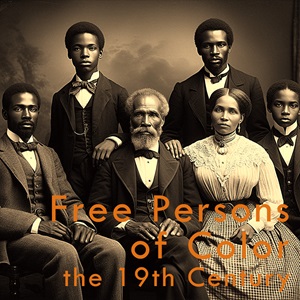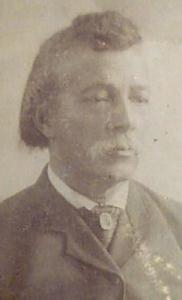 Enslavement
Enslavementto
freedom


Vibrant Black communities arise
from the ashes of slavery
Study Areas
John G. Chaplin, 1828 - 1907
Afrolumens is grateful to Charles Anderson Robinson for the submission of much material about his third great grandfather, John G. Chaplin. Mr. Robinson is a family historian with the distinction of having eleven ancestors who served with the United States Colored Troops during the Civil War. He has also done much research into the Pennsylvania State Equal Rights League, of which his ancestor, William Nesbit, was president. The Nesbit and Chaplin families were joined when John Chaplin's daughter, Florence, married Charles, son of William Nesbit. Most of what we know about the life of John G. Chaplin is due to research by Ms. Nancy Shedd.
John G. Chaplin was the oldest son of Huntingdon, Pennsylvania barber Levi and his wife Sophia. "The Chaplins have been In Huntingdon as far back as 1810," notes family historian Charles Robinson, who believes the family descended from slaves brought into Pennsylvania about 1785 by Maryland slaveholder Joseph Norris. Pennsylvania law would not allow slaves to be brought into the commonwealth from neighboring states, so the ancestors of Levi and Sophia would have been manumitted, perhaps after a period of indenture, and ultimately freed. At some point the family took up barbering, one of only a few professions open to African Americans at that time. Levi had a shop in Huntingdon as early as 1843, called the "Temple of Fashion." Most of his sons, including his eldest, John, followed him into the family business.

John, however, had an artistic talent that led him from Huntingdon to Philadelphia, where he studied under an accomplished African American artist, Robert Douglass, Jr. (1809-1887), who in turn had studied under Thomas Sully. Douglass, cousin to abolitionist Frederick Douglass, had taken an interest in helping promote talented African American artists. In addition to Chaplin, Douglass also taught David Bustill Bowser, later notable for his portraits of John Brown and Abraham Lincoln. Through the efforts and backing of Robert Douglass, Jr., John Chaplin was able to travel to the West Indies to continue his study of art, and eventually he made it to Dusseldorf.
Once back in America, John soon returned to Huntingdon, married Hannah Penlow in 1852 and settled into a life less glamorous. He resumed the family occupation of barbering, and by 1860 had a household filled with small children and other dependents, including his aged mother-in-law. These responsibilities kept him busy in the barber shop, but he still found time to produce numerous paintings that established his reputation as a serious artist.
Local newspapers reported his artistic successes: his large oil painting "The Death of Hannibal" was described as superb, and garnered a cash prize of three dollars at the 1856 Huntingdon Fair. He delved into portraiture and classical subjects, continually winning acclaim. His artistic fame began to spread throughout the state, and he was cited by T. Morris Chester, in a speech to the Philadelphia Library Company in 1862, as an example of African American artistic merit, to replace paintings done by white artists, of white subjects, that decorated the walls of many homes.
John G. Chaplin became involved with the political spectrum, serving as president of the Huntingdon chapter of the Pennsylvania State Equal Rights League. He represented Huntingdon at League events in Pittsburgh and Harrisburg, and reviewed returning U.S. Colored Troops at Harrisburg in November 1865, sharing the stage with such African American notables as William Howard Day, Stephen Smith, T. Morris Chester, O.L.C.Hughes, Thomas Dorsey, Joseph Pople, Octavius Catto, Jacob C. White, John Peck, George Vashon (his cousin), Joseph Bustill, and many others. Chaplin's involvement with the Pennsylvania Equal Rights League was a natural fit, as his interest in politics and activism was no doubt strengthened by his association with Douglass in Philadelphia. His daughter Florence would later marry the son of the league's founder and first president, William Nesbit.1
After the war Chaplin continued his work with classical subjects, painting large oils such as "The Dream of Nebuchadnezzar," and depicting well known scenes from literature such as "Macbeth Frightened by Banquos' Ghost," and "The Casket Choosing Scene from The Merchant of Venice." He also exhibited at the 1876 Centennial Exhibition in Philadelphia. At this time Chaplin was also painting many portraits, and probably derived a good extra income from them, while still practicing barbering. He became a very well known figure around Huntingdon, as famous for his worldliness and elan as for his artistic skills. Local news articles referred to him as "the Professor," and "John DeChapalili." Chaplin played this role to the hilt, dressing the part of a stylish gentleman and regaling his customers with stories--many obviously false--of his exploits and heritage.
Chaplin continued to receive numerous commissions for paintings and portraits into the 1890's, and continued to paint large canvas portraits and scenes, even as he began to suffer the affects of old age. In 1895 he and his wife Hannah moved to Youngstown, Ohio to live with a daughter and son-in-law. His obituary noted that he continued to paint to the day of his death, despite failing eyesight. On the day he died he was on his way to the barber shop of Samuel Stewart. Whether he was going to Stewarts to pass the afternoon in pleasant conversation with a fellow barber, or to visit his painting, "The Duel," which hung in Stewart's shop, is lost to history. On his way, while walking along the tracks of the Pennsylvania Railroad, John G. Chaplin was struck and killed by a passing train.
Notes
1. Harrisburg historian Calobe Jackson, Jr., notes that William Nesbit debated Thomas Morris Chester on the subject of Liberia at a Harrisburg church in 1857. Click here for Mr. Jackson's letter.
Sources
- Charles Anderson Robinson, email correspondence to the Afrolumens Project, 20, 22, 24, 30 January 2006
- Nancy Shedd, "Program on John G. Chaplin for the Huntingdon Historical Society, May 1, 1984," typescript, n.p.
- "Another County Equal Rights League," The Christian Recorder, 18 March 1865.
- Thomas Morris Chester, "Negro Self-Respect and Pride of Race," Speech delivered before the Philadelphia Library Company, December 9, 1862.
- Obituary of John G. Chaplin, Youngstown Vindicator, 6 January 1907.
- Obituary of John G. Chaplin, Youngstown Telegram, 7 January 1907.
- 1860 U.S. Census, Huntingdon Borough, Huntingdon County, Pennsylvania, p. 338-339.
Click here for the news article about John G. Chaplin's death, 1907.